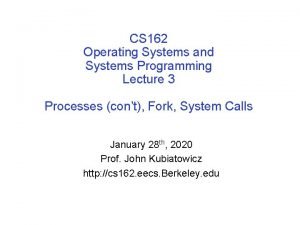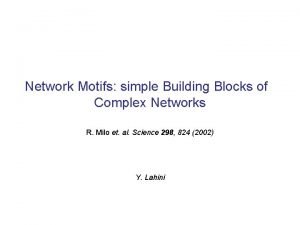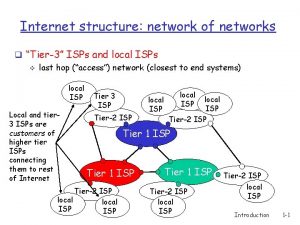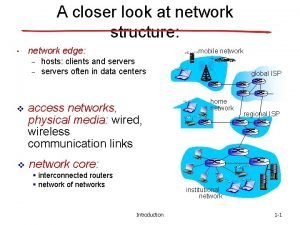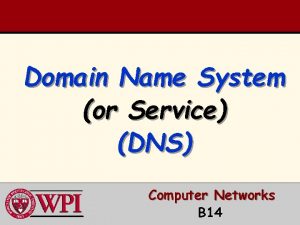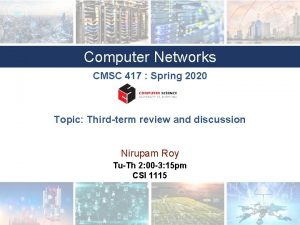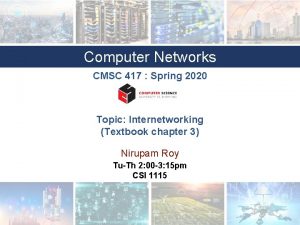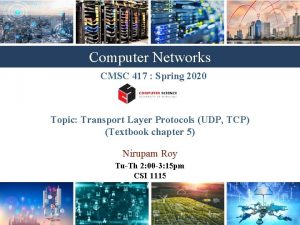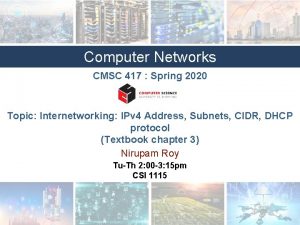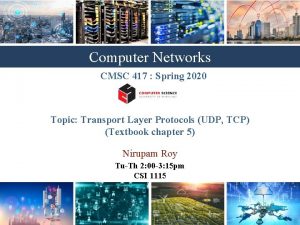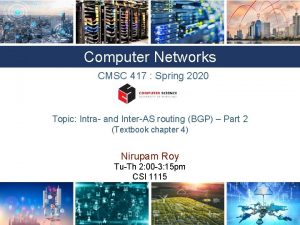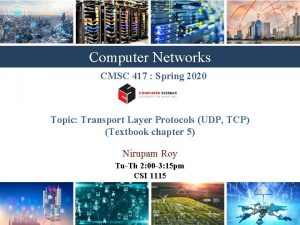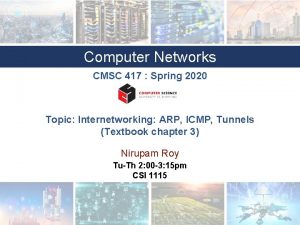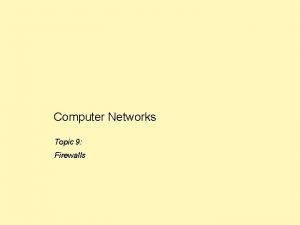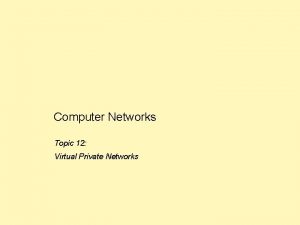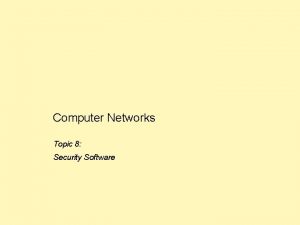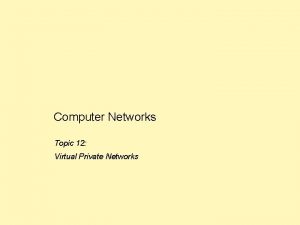Computer Networks CMSC 417 Spring 2020 Topic Network










![Symmetric key crypto: DES: Data Encryption Standard US encryption standard [NIST 1993] 56 -bit Symmetric key crypto: DES: Data Encryption Standard US encryption standard [NIST 1993] 56 -bit](https://slidetodoc.com/presentation_image_h2/9499d656b6eb74c5183e873be4912a79/image-11.jpg)




































- Slides: 47

Computer Networks CMSC 417 : Spring 2020 Topic: Network Security (Textbook chapter 8) Nirupam Roy Tu-Th 2: 00 -3: 15 pm CSI 1115 1

Chapter 8: Network Security Chapter goals: • understand principles of network security: • cryptography and its many uses beyond “confidentiality” • authentication • message integrity • security in practice: • firewalls and intrusion detection systems • security in application, transport, network, link layers 2

Outline q What is Network Security? q. Principles of Cryptography q Authentication, Message Integrity q Securing TCP: SSL/TLS 3

What is network security? confidentiality: only sender, intended receiver should “understand” message contents • sender encrypts message • receiver decrypts message authentication: sender, receiver want to confirm identity of each other message integrity: sender, receiver want to ensure message not altered (in transit, or afterwards) without detection access and availability: services must be accessible and available to users 4

Friends and enemies: Alice, Bob, Trudy • well-known in network security world • Bob, Alice (lovers!) want to communicate “securely” • Trudy (intruder) may intercept, delete, add messages Alice Bob channel data secure sender data, control messages secure receiver s data Trudy 5

Who might Bob, Alice be? • … well, real-life Bobs and Alices! • Web browser/server for electronic transactions (e. g. , on-line purchases) • on-line banking client/server • DNS servers • routers exchanging routing table updates • Many other examples! 6

There attackers out there! Q: What can an “attacker” do? A: A lot! • eavesdrop: intercept messages • actively insert messages into connection • impersonation: can fake (spoof) source address in packet (or any field in packet) • hijacking: “take over” ongoing connection by removing sender or receiver, inserting himself in place • denial of service: prevent service from being used by others (e. g. , by overloading resources) 7

Outline ü What is Network Security? q Principles of Cryptography q Authentication, Message Integrity q Securing TCP: SSL/TLS 8

The language of cryptography Alice’s K encryption A key plaintext encryption algorithm Bob’s K decryption Bkey ciphertext decryption plaintext algorithm m plaintext message E(KA, m) ciphertext, encrypted with key KA m = D(KB, E(KA, m)) 9

Symmetric key cryptography KS KS plaintext message, m encryption algorithm ciphertext E(KS, m) decryption plaintext algorithm m = D(KS, E(KS, m)) symmetric key crypto: Bob and Alice share same (symmetric) key: K S 10
![Symmetric key crypto DES Data Encryption Standard US encryption standard NIST 1993 56 bit Symmetric key crypto: DES: Data Encryption Standard US encryption standard [NIST 1993] 56 -bit](https://slidetodoc.com/presentation_image_h2/9499d656b6eb74c5183e873be4912a79/image-11.jpg)
Symmetric key crypto: DES: Data Encryption Standard US encryption standard [NIST 1993] 56 -bit symmetric key, 64 -bit plaintext input block cipher with cipher block chaining how secure is DES? • DES Challenge: 56 -bit-key-encrypted phrase decrypted (brute force) in less than a day • no known good analytic attack • making DES more secure: • 3 DES: encrypt 3 times with 3 different keys • • 11

Symmetric key crypto: DES operation initial permutation 16 identical “rounds” of function application, each using different 48 bits of key final permutation 12

AES: Advanced Encryption Standard • symmetric-key NIST standard, replaced DES (Nov 2001) • processes data in 128 bit blocks • 128, 192, or 256 bit keys • brute force decryption (try each key) taking 1 sec on DES, takes 149 trillion years for AES 13

Public Key Cryptography symmetric key crypto public key crypto • requires sender, receiver know shared secret key • Q: how to agree on key in first place (particularly if never “met”)? § radically different approach [Diffie. Hellman 76, RSA 78] § sender, receiver do not share secret key § public encryption key known to all § private decryption key known only to receiver 14

Public key cryptography + Bob’s public B key K K plaintext message, m encryption algorithm ciphertext E(KB+, m) - Bob’s private B key decryption algorithm plaintext message m=D(KB-, E(KB+, m)) 15

Public key encryption algorithms requirements: . . B + - ( ) such that need K ( ) and K 1 B D(KB-, E(KB+, m))=m 2 given public key K +, it should be B impossible* to compute private key K B RSA: Rivest, Shamir, Adleman algorithm 16

RSA: getting ready • message: just a bit pattern • bit pattern can be uniquely represented by an integer number • thus, encrypting a message is equivalent to encrypting a number example: • m= 10010001. This message is uniquely represented by the decimal number 145. • to encrypt m, we encrypt the corresponding number, which gives a new number (the ciphertext). 17

RSA: Creating public/private key pair 1. choose two large prime numbers p, q. (e. g. , 1024 bits each) 2. compute n = pq, z = (p-1)(q-1) 3. choose e (with e<n) that has no common factors with z (e, z are “relatively prime”). 4. choose d such that ed-1 is exactly divisible by z. (in other words: ed mod z = 1 ). 5. public key is (n, e). private key is (n, d). + KB - KB 18

RSA: encryption, decryption 0. given (n, e) and (n, d) as computed above 1. to encrypt message m (<n), compute c = m e mod n 2. to decrypt received bit pattern, c, compute m = c d mod n magic happens! m = (m e mod n) d mod n c 19

RSA example: Bob chooses p=5, q=7. Then n=35, z=24. e=5 (so e, z relatively prime). d=29 (so ed-1 exactly divisible by z). encrypting 8 -bit messages. encrypt: decrypt: bit pattern m me 0000 l 000 12 24832 c 17 c d 48196857210675091411825223071697 c = me mod n 17 m = cdmod n 12 20

Why does RSA work? • must show that cd mod n = m where c = me mod n • fact: for any x and y: xy mod n = x(y mod z) mod n • where n= pq and z = (p-1)(q-1) • thus, cd mod n = (me mod n)d mod n = med mod n = m(ed mod z) mod n = m 1 mod n =m 21

RSA: another important property The following property will be very useful later: - + K (K (m)) = m B B use public key first, followed by private key = + K (K (m)) B B use private key first, followed by public key result is the same! 22

Why - + K (K (m)) = m B B = + K (K (m)) B B ? follows directly from modular arithmetic: (me mod n)d mod n = med mod n = mde mod n = (md mod n)e mod n 23

Why is RSA secure? • suppose you know Bob’s public key (n, e). How hard is it to determine d? • essentially need to find factors of n without knowing the two factors p and q • fact: factoring a big number is hard 24

RSA in practice: session keys • exponentiation in RSA is computationally intensive • DES is at least 100 times faster than RSA • use public key crypto to establish secure connection, then establish second key – symmetric session key – for encrypting data session key, KS • Bob and Alice use RSA to exchange a symmetric key KS • once both have KS, they use symmetric key cryptography 25

Outline ü What is Network Security? ü Principles of Cryptography q Authentication, Message Integrity q Securing TCP: SSL/TLS 26

Authentication Goal: Bob wants Alice to “prove” her identity to him Protocol ap 1. 0: Alice says “I am Alice” Failure scenario? ? 27

Authentication Goal: Bob wants Alice to “prove” her identity to him Protocol ap 1. 0: Alice says “I am Alice” in a network, Bob can not “see” Alice, so Trudy simply declares herself to be Alice 28

Authentication: another try Protocol ap 2. 0: Alice says “I am Alice” in an IP packet containing her source IP address Alice’s IP address “I am Alice” Failure scenario? ? 29

Authentication: another try Protocol ap 2. 0: Alice says “I am Alice” in an IP packet containing her source IP address Alice’s IP address “I am Alice” Trudy can create a packet “spoofing” Alice’s address 30

Authentication: another try Protocol ap 3. 0: Alice says “I am Alice” and sends her secret password to “prove” it. Alice’s IP addr Alice’s “I’m Alice” password Alice’s IP addr OK Failure scenario? ? 31

Authentication: another try Protocol ap 3. 0: Alice says “I am Alice” and sends her secret password to “prove” it. Alice’s IP addr Alice’s “I’m Alice” password Alice’s IP addr OK playback attack: Trudy records Alice’s packet and later plays it back to Bob Alice’s “I’m Alice” password 32

Authentication: yet another try Protocol ap 3. 1: Alice says “I am Alice” and sends her encrypted secret password to “prove” it. Alice’s encrypted “I’m Alice” IP addr password Alice’s IP addr OK Failure scenario? ? 33

Authentication: yet another try Protocol ap 3. 1: Alice says “I am Alice” and sends her encrypted secret password to “prove” it. Alice’s IP addr encrypted “I’m Alice” password Alice’s IP addr OK record and playback still works! encrypted “I’m Alice” password 34

Authentication: yet another try Goal: avoid playback attack nonce: number (R) used only once-in-a-lifetime ap 4. 0: to prove Alice “live”, Bob sends Alice nonce, R. Alice must return R, encrypted with shared secret key “I am Alice” R KA-B (R) Alice is live, and only Alice knows key to encrypt nonce, so it must be Alice! Failures, drawbacks? 35

Authentication: ap 5. 0 ap 4. 0 requires shared symmetric key • can we authenticate using public key techniques? ap 5. 0: use nonce, public key cryptography “I am Alice” “send me your public key” + KA E(KA+, R) R 36

ap 5. 0: security hole man (or woman) in the middle attack: Trudy poses as Alice (to Bob) and as Bob (to Alice) I am Alice Send me your public key + KA E(KA+, R) R K + T E(KT+, R) R 37

ap 5. 0: security hole man (or woman) in the middle attack: Trudy poses as Alice (to Bob) and as Bob (to Alice) difficult to detect: § Bob receives everything that Alice sends, and vice versa. (e. g. , so Bob, Alice can meet one week later and recall conversation!) § problem is that Trudy receives all messages as well! 38

Digital signatures cryptographic technique analogous to hand-written signatures: • sender (Bob) digitally signs document, establishing he is document owner/creator. • verifiable, nonforgeable: recipient (Alice) can prove to someone that Bob, and no one else (including Alice), must have signed document 39

Digital signatures simple digital signature for message m: - • Bob signs m by signing with his private key KB, creating signed message, KB(m) Bob’s message, m Dear Alice Oh, how I have missed you. I think of you all the time! …(blah) Bob - Bob’s private KB key Public key signature algorithm m, S(KB-, m) Bob’s message, m, signed with his private key 40

Digital signatures § suppose Alice receives msg m, with signature: m, S(KB-, m) § Alice verifies m signed by Bob by using Bob’s public key KB+ to verify V(KB+, S(KB-, m) = True Alice thus verifies that: § Bob signed m § no one else signed m § Bob signed m and not m‘ non-repudiation: ü Alice can take m, and signature KB(m) to court and prove that Bob signed m 41

Outline ü What is Network Security? ü Principles of Cryptography ü Authentication, Message Integrity q Securing TCP: SSL/TLS 42

SSL/TLS: Transport Layer Security • widely deployed security protocol • supported by almost all browsers, web servers • https • billions $/year over TLS • mechanisms: [Woo 1994], implementation: Netscape • Current version: TLS 1. 2 • TLS 1. 3 (aka TLS 2 aka TLS 4 aka TLS 7 on the horizon) • provides • confidentiality • integrity • authentication • original goals: • Web e-commerce transactions • encryption (especially credit-card numbers) • Web-server authentication • optional client authentication • minimum hassle in doing business with new merchant • available to all TCP applications • secure socket interface 43

TLS and TCP/IP Application TLS TCP IP normal application TCP IP application with TLS § TLS provides application programming interface (API) to applications § C and Java TLS libraries/classes readily available 44

SSL Handshake overview 45

Outline ü What is Network Security? ü Principles of Cryptography ü Authentication, Message Integrity ü Securing TCP: SSL/TLS 46

Network Security (summary) basic techniques…. . . • cryptography (symmetric and public) • message integrity • end-point authentication …. used in many different security scenarios • secure email • secure transport (SSL) operational security: firewalls and IDS 47
 Cmsc417
Cmsc417 Cmsc417
Cmsc417 Cmsc 417
Cmsc 417 Internetwork
Internetwork Virtual circuits and datagram networks
Virtual circuits and datagram networks Basestore iptv
Basestore iptv Principles of network applications
Principles of network applications Design issues of network layer
Design issues of network layer Design issues of network layer
Design issues of network layer Network performance measurement in computer networks
Network performance measurement in computer networks Network performance measurement in computer networks
Network performance measurement in computer networks Network performance measurement in computer networks
Network performance measurement in computer networks Southwest airlines route map
Southwest airlines route map Joanna savarese
Joanna savarese Department of transportation
Department of transportation Ece 417 uiuc
Ece 417 uiuc Unit operations
Unit operations Research objectives
Research objectives Ece 417
Ece 417 Stripping rectifying section
Stripping rectifying section Octax collector
Octax collector Cast of spring, summer, fall, winter... and spring
Cast of spring, summer, fall, winter... and spring Fall winter spring summer months
Fall winter spring summer months Network topology in computer network
Network topology in computer network Painted paragraph strategy
Painted paragraph strategy What are the steps in narrowing down research topic
What are the steps in narrowing down research topic Spring io conference 2020
Spring io conference 2020 Math enrichment spring 2020
Math enrichment spring 2020 Cs162 spring 2020
Cs162 spring 2020 Pcnse certificate
Pcnse certificate Network motifs: simple building blocks of complex networks
Network motifs: simple building blocks of complex networks Internet structure network of networks
Internet structure network of networks Internet structure network of networks
Internet structure network of networks Crc in computer networks
Crc in computer networks Crc in computer networks
Crc in computer networks Traffic management in computer networks
Traffic management in computer networks Tanenbaum
Tanenbaum What is optimality principle in computer networks
What is optimality principle in computer networks Snmp supports which formatted protocol
Snmp supports which formatted protocol What is optimality principle in computer networks
What is optimality principle in computer networks Business application in computer network
Business application in computer network Classify computer networks based of transmission technology
Classify computer networks based of transmission technology Intro dns
Intro dns Diffserv vs intserv
Diffserv vs intserv Icmp in computer networks
Icmp in computer networks Http computer networks
Http computer networks Character stuffing in computer networks
Character stuffing in computer networks Dns in computer networks
Dns in computer networks




























